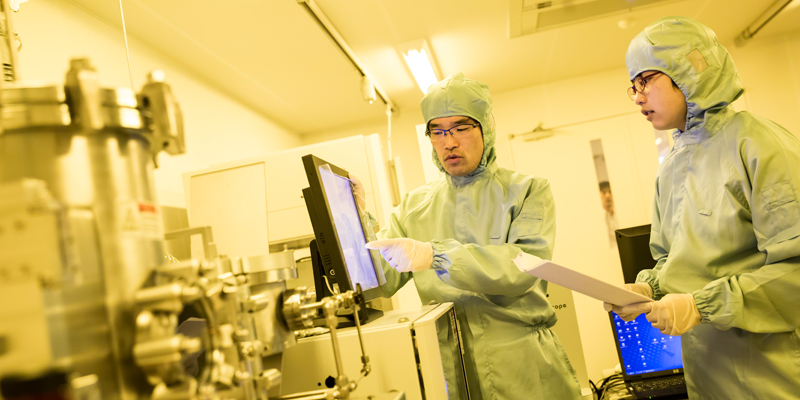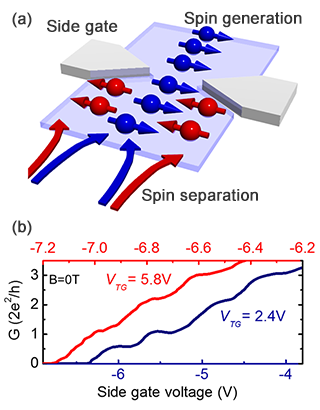

Figure 1(a). Schematic view of electronic spin separation by spin orbit interaction. (b) Quantized conductance as a function of side gate voltage in different top gate bias.
Electrons' angular momentum, known as spin, has been hailed as a novel degree of freedom in semiconductors because utilization of both the electrons' charge and spin enables the realization of electronic devices with faster operation and low-power consumption, so-called spintronic devices. To realize such spintronic devices, spin generation, manipulation and detection by electrical means are three important steps and would be preferable without using any external magnetic fields and magnetic materials for compatible operation to conventional semiconductor technologies. First step towards future spintronics application is an electrical spin generation in semiconductors and, based on this motivation, I have been working on the spin orbit interaction in III-V semiconductor heterostructures, i.e., an InGaAs/InAlAs quantum well. Although a spin orbit interaction originates from a relativistic effect and induces an effective magnetic field for an electron spin, it is similar to Biot-Savart's law, where a circular current induces a magnetic field at its center. So, spin orbit interaction makes spin splitting for up and down spins as an induced effective magnetic field being on the order of 10 Tesla. This large effective magnetic field enables us spin rotation in a micro-meter scale without using external magnetic fields and magnetic materials. But, if we want to generate spin polarization, we need another trick to separate up and down spins. In classical mechanics, force is defined by the spatial gradient of energy, F=dE/dx. Since spin splitting energy by spin orbit interaction is ESOI =± gμBBeff (g is the electron g factor, μB is the Bohr magneton and Beff is the effective magnetic field induced by spin orbit interaction), spin dependent force is generated by having the spatially modulated effective magnetic field, i.e., F =dESOI/dx=±
gμB
. This force acts as the separation of up and down spins in opposite directions. We implemented this idea using a semiconductor narrow constriction based on an InGaAs/InGaAsP heterostructure (Fig. 1(a)). The up and down electron spins are separated as the electrons flow into the constriction due to spatially dependent effective magnetic fields. Since accumulated blue spins at the channel center only go through the narrowest constriction, spin polarized electrons are generated. In such a constriction, often referred as a quantum point contact, we observed the quantized channel conductance in steps of (2e2/h) as a function of side gate bias voltage when weak spin orbit interaction [red line in Fig. 1(b)]. However, when the spatial modulation of effective magnetic field is enhanced [blue line in Fig. 1(b)], a spin-polarized conductance plateau is observed at 0.5(2e2/h), which corresponds to 70% spin polarization. This achievement opens up a way to seamlessly integrate electrical spin generation, manipulation, and detection in a single semiconductor device without external magnetic fields and materials.
Reference:
M. Kohda, et al., Nature Communications 3, 1038 (2012).


